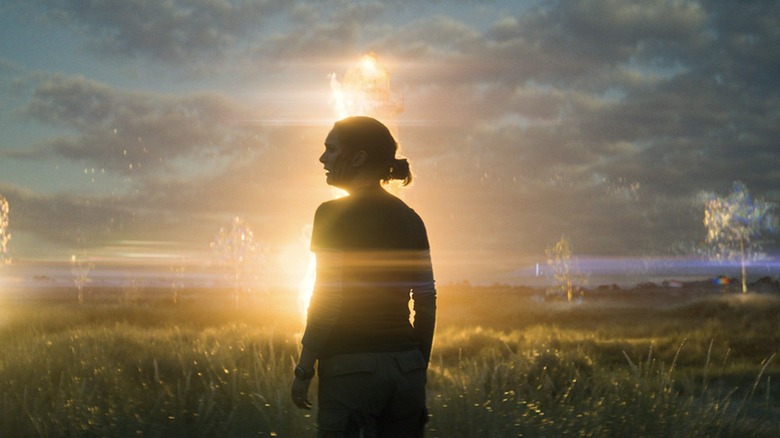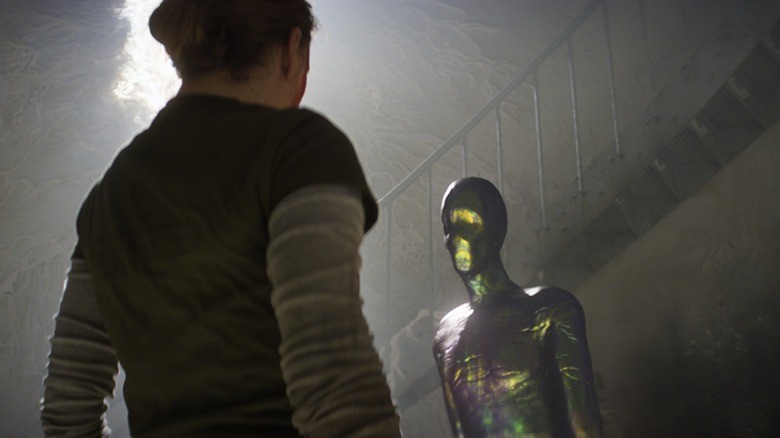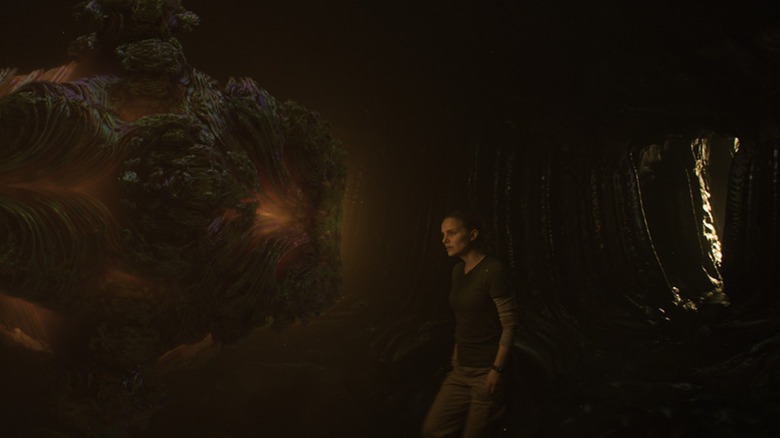The Most Confusing Moments In Annihilation, Explained
This post contains spoilers for Alex Garland's "Annihilation" and the source material.
Self-destruction is a sentiment wired into the human DNA. Irrespective of how put-together we feel about our standing with respect to the rest of humanity, these self-destructive tendencies, both overt and unconscious, creep in and threaten to tear us apart. It is relatively easy to capture the dramatic extremes of such a complex, universal feeling — one that is also so uniquely personal — but the nuances tend to be elusive, as these impulses remain indescribable. Alex Garland's stunning, uncompromising take on Jeff VanderMeer's first book in The Southern Reach Trilogy, "Annihilation," grabs these indescribable emotions by the throat, compelling us to look deep into the refracted images of our own selves with equal parts compassion and scrutiny. It is a film that can leave you feeling deeply moved, and deeply confused.
VanderMeer's first book in the trilogy is only a part of a whole. His "Annihilation" revolves around the mysterious Area X, which the film calls The Shimmer: a piece of land that does not follow the laws of nature, and every person who enters it faces death or comes back forever altered. Change is inevitable once you enter Area X, and the lifeforms that inhabit the area twist our understanding of known life forms, and how they can adapt in an environment so foreign to human perception. Although complex human intentions drive VanderMeer's book, it is tinted with unanswered questions, hope, and despair, like a puzzle that feels satisfying once you complete it, even if some pieces are missing here and there.
Garland's film cannot be treated as a puzzle, however, as it functions on a more metaphorical level. Here are some of the most confusing moments explained according to the crumbs scattered across this profound, jarring experience.
What does the opening lighthouse sequence in Annihilation mean?
Former soldier and cellular biology expert Lena (Natalie Portman) is under interrogation after her return from an expedition into the Shimmer, and her sole survivor status among a group of four puts her under intense scrutiny. The origins of the Shimmer are briefly explained, where a meteor landed near a lighthouse in the St. Mark's National Wildlife Refuge in Florida, causing the surrounding landscape to change and expand. While it is tempting to chalk up the Shimmer to aliens making a stake on the planet, the truth is far more uncomfortable and abstract: although the experiences of those who ventured into this space are alien, there are no entities that roam about the land. Instead, the sentience of the space feeds on the existing DNA in the area, constantly refracting parts of living beings until aberrations — both beautiful and terrifying — are formed.
The lighthouse is seminal to Lena's experience within the Shimmer, as it is a turning point in our understanding of what might have happened to everyone who returned. Her husband, Kane (Oscar Isaac) comes back completely changed, as if a shadowy mirage of his former self gradually deteriorating in real-time. Turns out, that is exactly the case, as the real Kane's body still lies inside the lighthouse, as he blew himself up with a phosphorous grenade before a replica of him emerges out of nowhere. This begs the question: can a refracted copy of the self still be considered human when its very essence is a borrowed one? For Kane, the answer is no, as he chooses death over the literal annihilation of the self, which is similar to the fate that Josie (Tessa Thompson) also willingly chooses after assimilating with the refracted plant forms in the Shimmer.
Why are the fates of the four expeditioners mired in mystery?
Throughout the interrogation, Lena emphasizes that she is not sure what exactly happened to the other women: physicist Josie is assimilated into nature, geomorphologist Cass (Tuva Novotny) gets mauled by a mutated bear, paramedic Anya (Gina Rodriguez) is also killed by the severely-refracted beast, and psychologist Dr. Ventress (Jennifer Jason Leigh) disintegrates into a strange, sentient cloud. Although we know what happened, unanswerable questions linger, and the most straightforward death is that of Cass', who falls prey to the vicious aspects of the morphing landscape. The mutated bear further assimilates the visceral fear and agony of Cass' dying moments, which explains why it mimics her desperate cries while attacking the group a second time.
Anya devolves into the most overt form of self-destruction, as her paranoia creates a divide between herself and the group, exacerbating an already messed-up situation. This behavior is in keeping with VanderMeer's description of people who entered the zone, where entire groups turned on one another in grotesque ways, and this is also reflected in Kane's group falling apart. When the people you travel with inside a treacherous zone change, such as the soldier with the snakelike intestines who morphs into a bleakly beautiful lichen mural, trust is hard to hold on to, as the self is subjected to similar change. While Kane carries out a complete erasure through self-destruction to assert autonomy over the self, Josie embraces the alien nature of the distortions to escape the pain of being molded into something more unrecognizably inhuman.
Meanwhile, Ventress seems to be in favor of the Shimmer devouring nature and deems such a DNA-level change inevitable, even if it means transforming into something deeply strange and inexplicable.
What happened to the two Lenas within the lighthouse?
The most disturbing part of "Annihilation," apart from the human-mimicking mutant bear, is the shimmering doppelgänger that Lena encounters inside the lighthouse. The cloud that Ventress dissolves into assimilates a drop of Lena's blood, her DNA, and gradually transforms into a mirrored version of herself, mimicking the person it is meant to copy. The escalating, anxiety-inducing soundtrack injects something deeply alienating into the sequence, where the real Lena watches her doppelgänger in awe and horror, where every movement is replicated in a twisted dance that eclipses verbal communication. It is hard to pinpoint whether this copy has any intentions of its own, let alone whether they are harmless or malevolent, but its almost childlike curiosity to mimic and adapt is fundamentally chill-inducing.
Although Lena tricks her mirrored copy into self-destruction and escapes the burning lighthouse (which collapses the Shimmer from the inside out), she is irrevocably changed due to her contact with something so alien. Towards the end, she is aware that Kane is not Kane, but she is also not the same woman who stepped inside the zone, as the Shimmer has completely reshaped her relationship with her husband and her own human shortcomings that are accompanied by tendencies to self-destruct. This is another step in mankind's genetic evolution, only the effects are unmappable, just like the Shimmer, which defies traditional concepts of space-time and the "natural" order of things.
The film ends with the bleak acceptance of this altered reality, and this sentiment also graces VanderMeer's final novel in the trilogy, titled "Acceptance," where a character travels through a portal and leaps into the mysterious light at the bottom of a tower after learning about the twisted origins of Area X.
The reason Annihilation feels like a dream morphing into a nightmare
In a conversation with The Ringer, Garland explained that he was drawn in by the intense atmosphere in VanderMeer's book, where he "found that reading the book was a weirdly similar experience to having a dream," a vision that he channeled through his "preoccupation" with the idea of innate self-destructive tendencies. Although Garland drew conscious and unconscious inspirations from other works of art, he mentions Andrei Tarkovsky's "Stalker," a seminal sci-fi entry that lent to the central concept of how the Shimmer would look and feel like. In Tarkovsky's film, a similar dreamlike no man's land called The Zone exists, off-limits to the populace, except for illegal guides known as stalkers who risk their lives to ferry people in and out.
Deep inside The Zone exists a space that can make anyone's deep wishes come true, which presents the philosophical turmoil of who we think we are versus how our unconscious desires manifest, changing the essence of our self. These desires are also linked to self-destruction, as the room that grants wishes demands every person to confront their soul in all its failings and complexities. Garland steers this impulse in a more jarring, violent way, where the basic tenets of our DNA are susceptible to changes that can erase the very essence of who we believe we are. The results can range from pretty flowers blooming on refracted bodies or mutant lichens invading the sanctity of human identity.
Inside the Zone, Area X, or the Shimmer, our carefully crafted moral cushions or emotional safety nets fall apart, and we are left with the raw, uncomfortable base impulses that drive us. How we choose to define our identities from this point onwards is a question dipped in slippery subjectivity.




